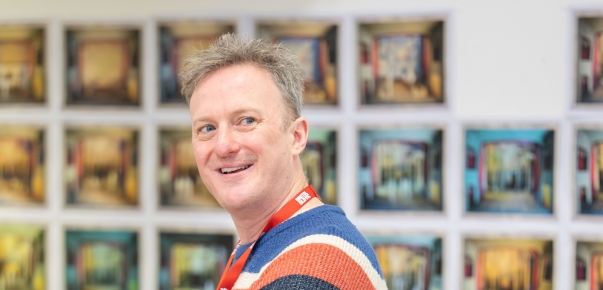The Light Burns Blue: Chasing Fairies - Silva Semerciyan
15 Apr 2015The Light Burns Blue has been a true labour of love. It began with an exciting brief: create a script with lots of great parts for girls as well as boys. I remember my own experience in youth theatre where at 5’8’’ tall, I seemed forever doomed to play secondary male parts. Not primary male parts, mind, as these required greater authenticity. It never occurred to me to blame the plays rather than my height. Why were there so few female parts? And why were we being forced to do plays with so many male characters when there were only two boys and thirty girls in the group? At last, thanks to Tonic Theatre and Bristol Old Vic, I’ve had the opportunity to help do something about it.
[gallery type="square" ids="176470761,176471805"]
It’s been a challenge to create fourteen female parts and six male parts, but I’ve had lots of help from the brilliant Lisa Gregan and a wonderful cast. They’ve inputted at every stage of the play’s development. Beginning with research and development workshops, Bristol Old Vic Young Company helped to test and fine-tune ideas for the show until finally voting on and selecting a nearly unanimous choice. The Cottingley Fairies inspired us with its fascinating characters, modern resonance and enduring mystery. Why did the girls take the photographs? And why did so many people believe in them? I was less interested in the fairies than in the photographs themselves. I was less interested in the esteemed gentlemen who espoused them than in a seventeen year old girl called Elsie Wright. Over the ensuing months, as we conducted more and more research, Elsie came into sharper and sharper focus. The established history of the case seemed to be overlooking her - or at least, not making enough fuss over her. The photographs were nowhere to be found in my anthology of the history of photography. Even my book on photographic fakery excluded them. It was time to put Elsie and her achievement at the centre of the action.
[caption id="attachment_176471807" align="alignnone" width="660"] Jenny Davies and Company in The Light Burns Blue. Photo by Paul Blakemore.[/caption]
Jenny Davies and Company in The Light Burns Blue. Photo by Paul Blakemore.[/caption]
It’s been a joyous process across these four months. The cast have responded to devising stimuli with tremendous wit and imagination. As ideas have been generated and explored, I’ve continually kept in mind a maxim I first heard from dramaturg Gavin Witt: ‘No work is wasted.’ In a devising process, inevitably some ideas must be scrapped, and sometimes it can be difficult to let go. One such scene in The Light Burns Blue was a cod Victorian pantomime about fairies. I thoroughly enjoyed writing it, but in the end, it just didn’t fit. Nevertheless, that work was not wasted. Sometimes it’s about eliminating possibilities. Sometimes it’s about effecting a change in attitude. Research for the scene has revolutionised my attitude toward Victorian theatre which I had previously regarded as a time of frivolity, scant plots that hinged on lockets and other tokens, two-dimensional characters and empty spectacle.
[caption id="attachment_176471808" align="alignnone" width="660"] Elana Binysh and Jenny Davies in The Light Burns Blue. Photo by Paul Blakemore.[/caption]
Elana Binysh and Jenny Davies in The Light Burns Blue. Photo by Paul Blakemore.[/caption]
In our research, Lisa and I were fortunate to meet with theatre historian Catherine Hindson at Bristol University. She led us into a basement room with a library trolley full of treasures from the university’s impressive archive. There were numerous illustrations of sets and costumes from various shows and a script entitled ‘Pinkie and the Fairies’ which included the delightful stage direction, ‘The fairies move fantastically.’ At one point, she donned white gloves with which to handle the precious items, and I suddenly understood how it must feel to be an archaeologist discovering the remains of Richard III. There were ornate tableaux which included casts of over two hundred. Today, a show with six actors is considered a large play. What must have been the effect of two hundred fairies on stage, occupying platforms that climbed higher and higher toward the proscenium arch? It occurred to me once again, how lucky I was to be working with Bristol Old Vic Young Company. What kind of stage pictures might twenty actors create? Crowds were possible. Village scenes were possible. A banquet was possible. There would be no need for minimalist sketches or shorthand. We would be able to offer a full and detailed spectacle that was far from empty.
[caption id="attachment_176471809" align="alignnone" width="660"] The Light Burns Blue Company. Photo by Paul Blakemore.[/caption]
The Light Burns Blue Company. Photo by Paul Blakemore.[/caption]
No work has been wasted. If, as Harold Rosenberg asserted, a work of art is a record of its creation, The Light Burns Blue is the final record of a creative process that has been inspiring, enlightening, moving and highly entertaining. I can’t help wishing Elsie Wright were here so we could ask her what she thinks.
The Light Burns Blue plays in Bristol Old Vic Studio between 15-18 April. Find out more, and book tickets here.


